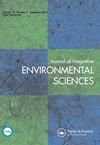Climate action in Indian cities: an emerging new research area
IF 3.5
4区 环境科学与生态学
Q3 ENVIRONMENTAL SCIENCES
Journal of Integrative Environmental Sciences
Pub Date : 2016-01-02
DOI:10.1080/1943815X.2015.1130723
引用次数: 20
Abstract
India is the fourth largest emitter of greenhouse gases globally, following China, the United States, and the European Union. Although India still has a low per capita carbon level, due to its large population and growing economy, its share of global greenhouse gas emissions is rising. India is, thus, a particularly important country to examine in relation to climate change. This article investigates one particular aspect of India’s climate policy: the role its cities play within its multi-tiered climate governance system. India is still a predominantly agricultural society with two-thirds of its population (about 850 million people) living in rural areas. Urbanization is, however, progressing; estimates are that India will add over 400 million urban dwellers between 2014 and 2050 bringing the urban population to over 800 million (United Nations, Department of Economic and Social Affairs, Population Division 2014). This article aims to shed light on the challenges, capabilities and limitations of India’s urban areas to deal with mitigating climate change. It complements the other articles in this special issue which focus on subnational state and provincial level climate policy. It takes as its starting point the academic multi-level climate governance debate and also looks at the role the co-benefit concept plays at the urban level. The article highlights key actors, drivers, and institutions of city climate action and considers how local climate policy and programs are enabled and constrained by India’s federal political system. Finally, the role of international city partnerships in supporting climate activities is considered. To explore the conditions shaping climate action in India’s cities this article builds on a literature review and discussions held at an Indian-German expert meeting which took place in Bangalore in April 2015.印度城市的气候行动:一个新兴的新研究领域
印度是全球第四大温室气体排放国,仅次于中国、美国和欧盟。尽管印度的人均碳排放水平仍然较低,但由于其庞大的人口和不断增长的经济,其在全球温室气体排放中的份额正在上升。因此,在气候变化方面,印度是一个特别重要的研究对象。本文研究了印度气候政策的一个特殊方面:印度城市在其多层次气候治理体系中所扮演的角色。印度仍然是一个以农业为主的社会,三分之二的人口(约8.5亿人)生活在农村地区。然而,城市化正在推进;据估计,2014年至2050年间,印度将增加4亿多城市居民,使城市人口超过8亿(联合国,经济和社会事务部,2014年人口司)。本文旨在揭示印度城市地区在应对减缓气候变化方面面临的挑战、能力和局限性。它补充了本期特刊中关注次国家和省级气候政策的其他文章。它以学术上的多层次气候治理争论为出发点,并着眼于共同利益概念在城市层面上所起的作用。本文重点介绍了城市气候行动的关键参与者、驱动因素和机构,并考虑了印度联邦政治体制如何推动和制约地方气候政策和计划。最后,讨论了国际城市伙伴关系在支持气候活动中的作用。为了探讨影响印度城市气候行动的条件,本文以2015年4月在班加罗尔举行的印德专家会议上的文献综述和讨论为基础。
本文章由计算机程序翻译,如有差异,请以英文原文为准。
求助全文
约1分钟内获得全文
求助全文
来源期刊

Journal of Integrative Environmental Sciences
ENVIRONMENTAL SCIENCES-
CiteScore
3.90
自引率
0.00%
发文量
13
审稿时长
>12 weeks
期刊介绍:
Journal of Integrative Environmental Sciences (JIES) provides a stimulating, informative and critical forum for intellectual debate on significant environmental issues. It brings together perspectives from a wide range of disciplines and methodologies in both the social and natural sciences in an effort to develop integrative knowledge about the processes responsible for environmental change. The Journal is especially concerned with the relationships between science, society and policy and one of its key aims is to advance understanding of the theory and practice of sustainable development.
 求助内容:
求助内容: 应助结果提醒方式:
应助结果提醒方式:


